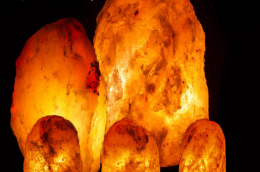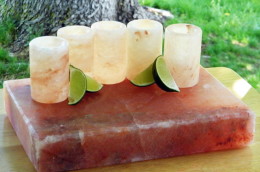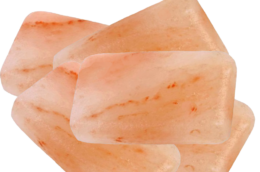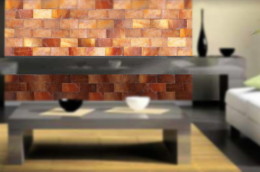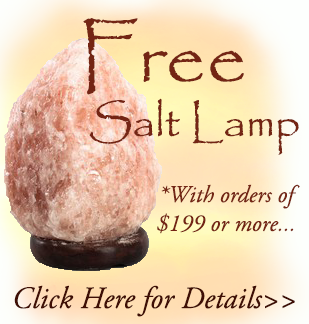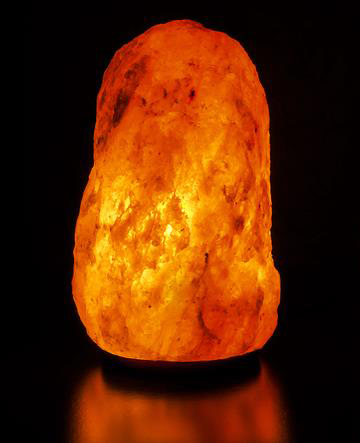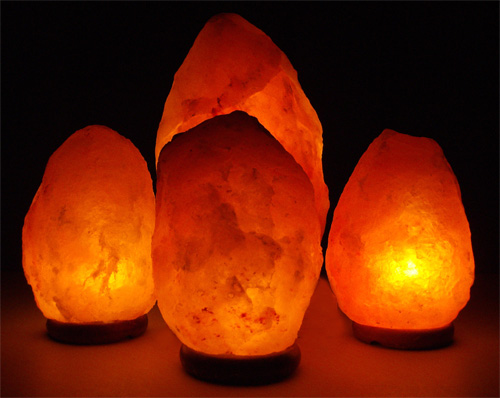Salt Wall Construction and Installation
A completely custom project, Salt Wall Construction and Installation techniques vary depending on the desired look and style of the salt wall. While salt walls can be constructed in the traditional “brick wall” style using standard masonry techniques and materials, other options can also be applied to create a more decorative salt wall feature. This article discusses some of the basic techniques and considerations for constructing salt walls, as well as some ideas for other custom salt block features as well.

Image courtesy of Infra World
When considering adding a salt wall to your home, the first thing you should do is consult a professional to ensure that the floor and wall structure you will be attaching the salt wall to is sturdy enough to hold the weight the salt. A salt wall can be very heavy, with a standard 2”x4”x8” block weighing about 7lbs, and an 8ft. x 8ft.wall weighing around 1344lbs., however most modern home construction will accommodate the weight of a salt wall. Weight is also a consideration when hanging movable salt features, such as mosaics built into a wooden frame structure; make sure that these are secured firmly to the wall supports (studs) to avoid injury and other damage.
Construction and Installation
Standard “brick wall” style salt walls may be constructed in the same manner as a normal brick wall, with the exception of the lighting behind the wall. A good example of a standard, existing backlit wall style is the common glass block walls found in bathrooms, spas, resorts, etc. Standard masonry, caulks, adhesives, and/or grouts may be used to secure the bricks in position, or special materials may be used to create a more decorative look. There should be a space between the salt bricks and the wall, enough to allow airflow between the salt block structure and the wall. There should also be sufficient access to facilitate regular maintenance of the lighting feature behind the salt block structure.
Free standing Himalayan Salt walls are also highly popular. Like the glass block walls we discussed above, salt walls can be installed entirely independent from other existing wall structures, providing the floor structure beneath the wall is sufficient to hold the weight. These standalone salt walls are a great option for adding partition walls to spaces such as open master bathrooms in master bedrooms, seclusion of hot tubs or Jacuzzi’s in large open spaces of the home, and creatively dividing larger rooms of the home into smaller ones.
Salt Walls in Humid or Moist Locations
Though installation of salt walls and features in bathrooms, and especially saunas, is a popular option and is often used to create a tranquil, spa-like atmosphere in those locations, any salt feature placed in a moist area will deteriorate/erode from frequent exposure to excessive moisture at a faster rate than those installed in dryer locations in the home. In fact, it will literally “melt” over time, and proper precautions should be taken to help preserve the wall, or protect the wall entirely.
If you live in a dry climate, and/or the salt wall or feature receives little to no exposure to moisture, a salt wall can last indefinitely, unless of course the blocks are damaged by an object hitting them, or shifting them to a degree that could cause damage.
If you live in a humid climate, the salt wall is likely to deteriorate over time; how fast depends on how much moisture the blocks come in contact with. This erosion process is most especially a concern when the blocks are exposed to direct contact with water on a regular basis, i.e. water actually running or flowing down the blocks, or, there is a high enough moisture content in the air to cause enough condensation for this to occur.
Even at this rate, the blocks are so dense that the wall will last some time before the erosion creates a problem, unless, a block has a natural fracture line where water can gain easier access into the block, these blocks will deteriorate at a quicker rate than blocks without fracture lines. Unfortunately, due to the nature of the salt blocks, it is common for the blocks to have natural fracture lines within them, and this is difficult to avoid.
Despite these obvious setbacks, installation of salt walls and features in bathrooms, and especially saunas, are particularly popular given the relaxing nature of these locations. Direct contact with water is generally avoided, and may be accomplished with the use of standard ventilation of the area when possible, and/or proper care and maintenance of salt features in these areas, as well as presumable applications of sealers or protective layers of glass, or acrylic.
For applications of salt walls in moist areas with no direct contact to running water, such as saunas and areas of the bathroom outside of tub and shower enclosures, most modern bathrooms use sufficient ventilation systems to avoid moisture accumulation in the room for the most part. Any excess moisture build up can be quickly removed after a shower, bath, or steam, by wiping down the salt wall or feature with a dry cloth or paper towel. Lastly, allowing the room or sauna to finish drying by leaving the door open and/or ventilation system on for a bit will help to ensure optimal longevity of the salt wall or feature for the given conditions.
There are also sealers that can be applied to the finished wall to help avoid erosion. For more information about sealers contacting a contractor or mason is recommended as they can offer ample information about available options.
In order to entirely protect a Salt Wall from moisture when use of a salt feature in an area with direct contact with running water is preferred, glass or acrylic coverings can be applied. However, covering the salt in this manner will not allow for the ionization process of heated salt to take place, as the salt must also have direct exposure to open air in order to deliver negative ions to the atmosphere. The wall will also need to be ventilated from inside if it is to be back lit, unless the lighting does not produce heat.
Lighting
There are various ways to backlight a salt wall, depending on the look you want to achieve and the electrical possibilities of the intended location. Again, salt walls are a completely custom project, and light rope, track lighting, tube lighting etc. have all been used in order to backlight salt block structures. It is important to note however, that optimal air ionization only takes place when the salt is exposed to heat, thus, in order to gain the air cleansing effects of the salt, the lighting used to light the wall must produce heat.
Rope lighting may be preferable if installing a light feature is not possible or not desired, and also offers the ability to easily replace lighting when needed, or switch it when preferred. This option is a great way to add colored lighting behind a salt wall for special occasions, and replace it with normal lighting the rest of the time; however this option may not provide suitable heat for optimal ionization effects.
Forms of lighting that can simply be plugged in to an outlet where the salt wall is located are often preferable in order to avoid the need for light fixture installation, which generally requires an electrician. Lighting that requires installation is also popular for backlighting salt walls and salt features, as it offers the ability to light the salt wall with the flick of a switch, and also allows for the use of lighting features that may be dimmed or brightened to varying degrees. Both of these lighting options may use the types of bulbs that will produce heat for optimal air ionization.
Framed Salt Walls & Features
This more detailed, decorative option for installing a salt wall is a perfect example of the custom design possibilities Salt Walls offer. Salt features contained within a decorative frame are a popular construction option for those who prefer a more customized, decorative salt feature. Salt walls and decorative features are often framed with wood, metal, and other materials to accent the salt feature, and/or to blend the salt feature into an existing décor theme.
Further demonstrating the versatility of salt wall décor, framed salt wall features also allow for installation of salt walls under countertops, such as the front side of a kitchen island, or a bar. These features can be incorporated into existing elements of the home for an entirely new look and feel.
Salt Blocks and Bricks
Saving the most important aspect of Himalayan Salt Walls and salt features for last, the salt blocks or bricks that are used to construct the salt wall or feature determine the ultimate beauty of the wall. The most captivating aspect of Himalayan Salt is the exemplary range of colors naturally present in the salt; however, not all Himalayan Salt is the same.
Salt obtained from deep below the surface displays the full range of colors possible in this natural element, varying from tranquil peach/pink hues to deep reds and oranges, with accents of these colors combining together throughout for a sensational display. Salt obtained closer to the surface will not possess the full range of colors possible in Himalayan Salt. To ensure optimal beauty in a salt wall or salt feature, quality Himalayan Salt blocks, possessing the full range of beautiful coloring naturally found in the harder to reach veins of salt, must be used.
Salt Lamp Additions for Coordination of Décor Theme
Upon installing a salt wall or salt feature in their home or business and discovering the captivating beauty and tranquil, earthy atmosphere it lends to the surrounding area, many individuals decide to further incorporate Himalayan Salt into their décor scheme with the addition of well-placed Himalayan Salt Lamps. (Click here to view our most popular Salt Lamp Set!)
Placing salt lamps elsewhere in the room or home easily pulls the décor theme together for a complete transformation of the indoor environment, creating a peaceful respite from the stresses of the day. If candle light is preferred, Himalayan Salt Candle Holders are an excellent way to add additional salt accents to the décor scheme, and are especially popular additions to bathrooms, around Jacuzzis, and on kitchen counter tops and dinner tables.
The versatile nature of Salt Wall Construction and Installation techniques, as well as the nature of the salt materials used to create these beautiful works of art have been the driving factors behind the popularity of the this wonderful air cleansing, home décor element.
As salt walls and features continue to be increasingly used in custom renovation and new design projects, both commercial and residential, admirers of these gorgeous features are likely to discover many new construction and installation techniques. The future of creative, functional, earthy home décor looks bright, and it glows in the all the warm colors of Himalayan Salt.
To purchase salt wall packages containing quality Himalayan Salt Blocks and Bricks with the full spectrum of natural coloring, Click Here>>
For information about Himalayan Salt Walls in bedrooms, Click Here>>
For information about the reputed health benefits of Himalayan Salt, Click Here>>

